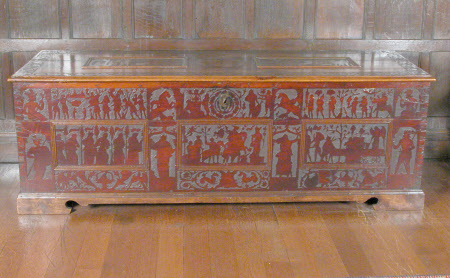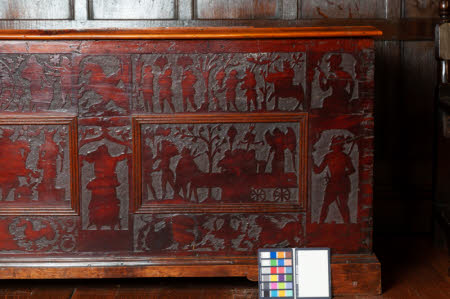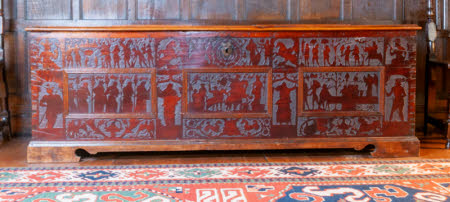Chest
Category
Furniture
Date
1580 - 1630
Materials
Cypress, wrought iron and brass
Measurements
62.5 x 181 x 61 cm
Place of origin
Venice
Order this imageCollection
Wightwick Manor, West Midlands
NT 1288219
Summary
A cypress and pen work chest, Venice, late 16th to early 17th century. Of dovetailed construction. The hinged lid carved in low-relief with two figural scenes, within applied mouldings, all within an outer border of foliated scrolls. The front with three figural scenes - one possibly of Apollo being drawn on a chariot - all within applied panel mouldings and surrounded by further figures and scenes, and all'antica scrolls. With iron carrying handles to the sides, raised on later low bracket feet.
Full description
Chests like this, made of cypress wood, were formerly attributed to the Alto Adige in northern Italy. It is now thought that many of them were carved in Venice, but that the chests themselves may have been imported from Crete, a Venetian dependency, where cypress trees were grown in plantations. The figural scenes which decorate these chests were derived from Italian, French and German engravings of Classical and courtly themes, which circulated widely in the 16th and 17th centuries. Chests (and boxes) like this were exported from Italy in very large numbers and, in the 16th and 17th centuries, were highly prized. Some of the scenes on Wightwick’s chest - almost certainly made to commemorate a marriage - derive from the poet Petrarch’s Triumphs, probably the Triumphs of Love and Chastity, which were hugely popular themes in art of the late Middle Ages and Early Modern period. Most show Love and Charity drawn on wheeled triumphal ‘cars’ drawn by a variety of animals (sometimes bulls, unicorns or even bears), surrounded by attendants in procession. The exact print source from which the Wightwick scenes derive is unknown. A very similar chest in the collection of Harvard Art Museum (1927.48) and a box in the V&A shows, to the underside of its lid, a procession with the leading horse rearing before a statue-like figure (W.3-1951) which relates very closely to the central panel of the front of the Wightwick chest and which may be by the same hand.
Provenance
In 1937 Geoffrey Le Mesurier Mander gifted Wightwick Manor, its gardens and many of its contents to the National Trust. Geoffrey and his family continued to occupy and manage Wightwick, adding to the collection in collaboration with the National Trust. Sir Geoffrey died in 1962 but Lady Mander continued to live at Wightwick until her death in 1988. These collection items are listed in the Wightwick Manor 1937 inventory.




